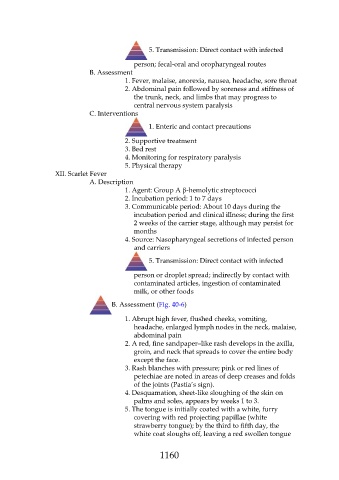Page 1160 - Saunders Comprehensive Review For NCLEX-RN
P. 1160
5. Transmission: Direct contact with infected
person; fecal-oral and oropharyngeal routes
B. Assessment
1. Fever, malaise, anorexia, nausea, headache, sore throat
2. Abdominal pain followed by soreness and stiffness of
the trunk, neck, and limbs that may progress to
central nervous system paralysis
C. Interventions
1. Enteric and contact precautions
2. Supportive treatment
3. Bed rest
4. Monitoring for respiratory paralysis
5. Physical therapy
XII. Scarlet Fever
A. Description
1. Agent: Group A β-hemolytic streptococci
2. Incubation period: 1 to 7 days
3. Communicable period: About 10 days during the
incubation period and clinical illness; during the first
2 weeks of the carrier stage, although may persist for
months
4. Source: Nasopharyngeal secretions of infected person
and carriers
5. Transmission: Direct contact with infected
person or droplet spread; indirectly by contact with
contaminated articles, ingestion of contaminated
milk, or other foods
B. Assessment (Fig. 40-6)
1. Abrupt high fever, flushed cheeks, vomiting,
headache, enlarged lymph nodes in the neck, malaise,
abdominal pain
2. A red, fine sandpaper–like rash develops in the axilla,
groin, and neck that spreads to cover the entire body
except the face.
3. Rash blanches with pressure; pink or red lines of
petechiae are noted in areas of deep creases and folds
of the joints (Pastia’s sign).
4. Desquamation, sheet-like sloughing of the skin on
palms and soles, appears by weeks 1 to 3.
5. The tongue is initially coated with a white, furry
covering with red projecting papillae (white
strawberry tongue); by the third to fifth day, the
white coat sloughs off, leaving a red swollen tongue
1160

